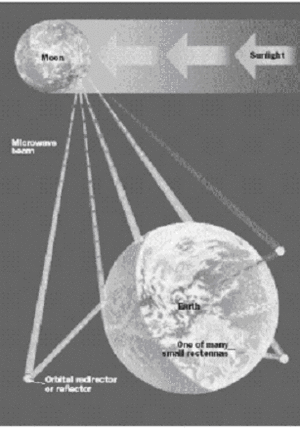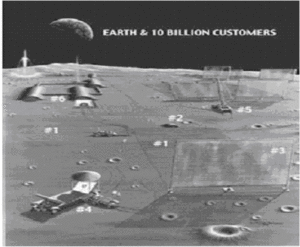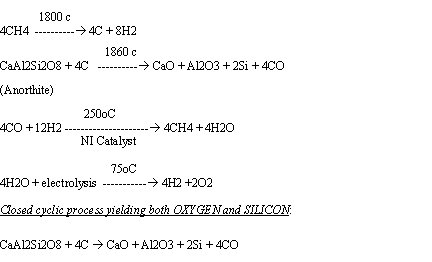
Solar power could be collected on the moon. Many different beams of 12cm wavelength microwaves would deliver power to receivers at sites located worldwide.[1] Each receiver would supply commercial power to a given region. Such a receiver, called a rectenna, would consist of a large field of small rectifying antennas. A beam with a maximum intensity of less than 20% of noontime sunlight would deliver about 200 W to its local electric grid for every square meter of rectenna area.
Unlike sunlight, microwaves pass through rain, clouds, dust, and smoke. Power can be supplied to the rectenna at night. Several thousand individual rectennas strategically located around the globe, with a total area of 100,000 km2, could continuously provide the 20 TW of electric power, or 2 kW per person, required for a prosperous world of 10 billion people in 2050.[2] This surface area is 5% of the surface area that would be needed on Earth to generate 20 TW using the most advanced terrestrial solar-array technology of similar average capacity now envisioned. Rectennas are projected to cost approximately $0.004/kWh, which is less than one-tenth of the current cost of most commercial electric energy. (Note this claim is highly debatable - and it has been argued that because of physical constraints LSP can not be as inexpensive as terrestrial solar power in Physics and Society)
This new electric power would be provided without any significant use of Earth's resources several types of solar power satellites have been proposed. They are projected, over 30 years, to deliver approximately 10,000 kWoh of electric energy to Earth for each kilogram of mass in orbit around the planet. To sell electric energy at $0.01/ kWoh, less than $60 could be expended per kilogram to buy the components of the power satellites, ship them into space, assemble and maintain them, decommission the satellites, and finance all aspects of the space operations. To achieve this margin, launch and fabrication costs would have to be lowered by a factor of 10,000. Power prosperity would require a fleet of approximately 6,000 huge, solar-power satellites. The fleet would have more than 330,000 km2 of solar arrays on-orbit and a mass exceeding 300 million tones. By comparison, the satellite payloads and rocket bodies now in Earth geosynchronous orbit have a collective surface area of about 0.1 km2.
Lunar Solar Collectors[edit | edit source]
Lunar Solar Power (LSP) System, an appropriate, natural satellite is available for commercial development. The surface of Earth's moon receives 13,000 TW of absolutely predictable solar power. The LSP System uses 10 to 20 pairs of bases-one of each pair on the eastern edge and the other on the western edge of the moon, as seen from Earth-to collect on the order of 1% of the solar power reaching the lunar surface. The collected sunlight is converted to many low intensity beams of microwaves and directed to rectennas on Earth. Each rectenna converts the microwave power to electricity that is fed into the local electric grid. The system could easily deliver the 20 TW or more of electric power required by 10 billion people. Knowledge of the moon and practical technologies has been available since the late 1970s to collect this power and beam it to Earth. Successful Earth-moon power beams are already in use by the Arecibo planetary radar, operating from Puerto Rico. This radio telescope periodically images the moon for mapping and other scientific studies with a radar beam whose intensity in Earth's atmosphere is 10% of the maximum proposed for the LSP System. Each lunar power base would be augmented by fields of solar converters located on the back side of the moon, 500 to 1,000 km beyond each visible edge and connected to the earthward power bases by electric transmission lines. The moon receives sunlight continuously except during a full lunar eclipse, which occurs approximately once a year and lasts for less than three hours. Energy stored on Earth as hydrogen, synthetic gas, dammed water, and other forms could be released during a short eclipse. Each lunar power base consists of tens of thousands of power plots figure distributed in an elliptical area to form fully segmented, phased-array radar that is solar-powered. Each demonstration power plot consists of four major subsystems. Solar cells collect sunlight, and buried electrical wires carry the solar energy as electric power to microwave generators. These devices convert the solar electricity to microwaves of the correct phase and amplitude and then send the microwaves to screens that reflect microwave beams toward Earth.

Rectennas located on Earth between 60º N and 60º S can receive power directly from the moon approximately 8 hours a day. Power could be received anywhere on Earth via a fleet of relay satellites in high inclination, eccentric orbits around Earth. A given relay satellite receives a power beam from the moon and retransmits multiple beams to several rectennas on Earth required by an alternative operation. This enables the region around each rectenna to receive power 24 hours a day. The relay satellites would require less than 1% of the surface area needed by a fleet of solar-power satellites in orbit around Earth. Synthetic-aperture radars, such as those flown on the Space Shuttle, have demonstrated the feasibility of multibeam transmission of pulsed power directed to Earth from orbit. Relay satellites may reflect the beam or may receive the beam, convert it in frequency and phasing and then, transmit a new beam to the rectenna. A retransmitter satellite may generate several beam and simultaneously service several rectennas. The orbital reflector and retransmitter satellites minimize the need on earth for long distance power lines. Relay satellites also minimize the area and mass of power handling equipments in orbit around earth. There by reducing the hazards of orbital debris to space vehicles and satellites.
Fabrication of Thin Film Crystalline Silicon Solar Cells[edit | edit source]
The silicon film is a proprietary process, and only a very general process is designed.[3] The generic process consists of ceramic formation, metallurgical barrier formation, polycrystalline layer deposition, emitter diffusion and contact fabrication. The conductive ceramic substrate is fabricated from selected low-cost materials. The metallurgical barrier prevents the substrate impurities from entering and contaminating the active thin silicon layer. The randomly textured and highly reflecting metallurgical barrier improves light trapping. A suitable p- type doped 30 - 100micro-cm active layer is deposited from a liquid solution. Phosphorus and aluminum impurity gathering are used for bulk quality improvement. Cells with large areas of 240, 300 and 700 cm2 are developed. A cell with an area of 675 cm2 has demonstrated the record efficiency of 11.6 - 17.7%.[4]The waste products present in the lunar surface are silicon, iron, TiO2, etc. These products can be used as raw materials for solar cell fabrication. A special compound called anorthite is used for extracting the above said components. Carbothermal reduction of anorthite,
Carbon compounds can also be used to extract Oxygen, Fe, and TiO2 from Lunar Ilemenite. The iron is used for interconnect and TiO2 for anti reflect.
Microwave[edit | edit source]
For direct microwave wireless power transmission to the surface of the earth, a limited range of transmission frequencies is suitable. Frequencies above 6 GHz are subject to atmospheric attenuation and absorption, while frequencies below 2 GHz require excessively large apertures for transmission and reception. Efficient transmission requires the beam have a Gaussian power density. Transmission efficiency çb for Gaussian beams is related to the aperture sizes of the transmitting and receiving antennas: çb ~ 1- exp (-ô2) and ô = ðDtDr/ (4ëR) Where Dt is the transmitting array diameter, Dr is the receiving array diameter, çb.is the wavelength of transmission and R is the range of transmission. Frequencies other than 2.45 GHz, particularly 5.8 GHz and 35 GHz are being given greater attention as candidates for microwave wireless power transmission in studies and experiments. The mass and size of components and systems for the higher frequencies are attractive. However, the component efficiencies are less than for 2.45 GHz, and atmospheric attenuation, particularly with rain, is greater.
Cost[edit | edit source]
To achieve low unit cost of energy, the lunar portions of the LSP System are made primarily of lunar derived components. Factories, fixed and mobile, are transported from the Earth to the Moon. High output greatly reduces the impact of high transportation costs from the Earth to the Moon. On the Moon the factories produce 100s to 1,000s of times their own mass in LSP components. Construction and operation of the rectennas on Earth constitutes greater than 90% of the engineering costs. Any handful of lunar dust and rocks contains at least 20% silicon, 40% oxygen, and 10% metals (iron, aluminum, etc.).[5] Lunar dust can be used directly as thermal, electrical, and radiation shields, converted into glass, fiberglass, and ceramics, and processed chemically into its elements. Solar cells, electric wiring, some micro-circuitry components, and the reflector screens can be made out of lunar materials. Soil handling and glass production are the primary industrial operations. Selected micro circuitry can be supplied from Earth. Use of the Moon as a source of construction materials and as the platform on which to gather solar energy eliminates the need to build extremely large platforms in space. LSP components can be manufactured directly from the lunar materials and then immediately placed on site. This eliminates most of the packaging, transport, and reassembly of components delivered from Earth or the Moon to deep space. There is no need for a large manufacturing facility in deep space. The LSP System is the only likely means to provide 20 TWe of affordable electric power to Earth by 2050. According to Criswell in the year 1996 lunar solar power reference design for 20,000GWe. It's also noted that the total mass investment for electricity from lunar solar energy is less than for Terrestrial solar energy systems. The terrestrial thermal power system produces up to 310,000 tones / GWe. Terrestrial photovoltaic makes up too 430,000 tones / GWe and lunar solar power produces 52,000 tones / GWe.
LSP aspects[edit | edit source]
In technical and other aspects there are two reasons for which we prefer LSP are: unlike earth, the, moon is the ideal environment for large area solar converters.
The solar flux to the lunar surface is predictable and dependable.
- There is no air or water to degrade large area thin film devices.
- Solar collectors can be made that are unaffected by decades of exposure to solar cosmic rays and the solar wind.
- Sensitive circuitry and wiring can be buried under a few- tens of centimeters of lunar soil, and completely protected against solar radiations temperature extremes.
Secondly, virtually all the LSP components can be made from local lunar materials.
- The high cost of transportation to and from the moon is canceled out by sending machines and small factors to the moon that produce hundreds to several thousand times there own mass in components and supplies.
- Lunar materials will be used to reduce the cost of transportation between the earth and the moon and provide supplies.
Constant power[edit | edit source]
Note that there is no "dark side of the moon" - there is just a side of the moon which always faces the earth. To achieve consistent power 24 hours, any time of the month, solar arrays must be placed in a number of locations around the moon.
Solar Cells[edit | edit source]
- Crystalline silicon solar cells almost completely dominate world - wide solar cell production.
- Excellent stability and reliability plus continuous development in cell structure and processing make it very likely that crystalline silicon cells will remain in this position for the next ten years.
- Laboratory solar cells, processed by means of sophisticated micro - electronic techniques using high quality Fe-Si substrate have approached energy conversion efficiencies of 24%.
References[edit | edit source]
- "Lunar Solar Power Generation" by V.LALITH KUMAR
- Wikipedia: lunar solar power
- Institute of Space Systems Operations (ISSO): Criswell - Publications and Abstracts
- "Lunar resources utilization for space construction" by General Dynamics: describes building space power satellites out of mostly lunar material.
- ↑ R. Criswell, D. (s. f.). Solar Power via the Moon. The Industrial Physicist. https://www.public.asu.edu/~gbadams/moonpower.pdf
- ↑ Ibíd (1).
- ↑ McEvoy, A., Markvart, T. & Castañer, L. (2012) Practical Handbook of Photovoltaics - Fundamentals and Applications. Academic Press. https://www.sciencedirect.com/book/9780123859341/practical-handbook-of-photovoltaics#book-info
- ↑ Kumaraswamy, E., Lalith Anuroop, L., & Sindhuja. (2014). Vigorous Generation of Electric Power by Implementing Lunar Power System. Int. Journal of Engineering Research and Applications, Vol. 4. https://www.ijera.com/papers/Vol4_issue4/Version%208/V04408111115.pdf
- ↑ Overview of the LSP System - Energy Strategies. (2023, 25 octubre). Climate Policy Watcher. https://www.climate-policy-watcher.org/energy-strategies/overview-of-the-lsp-system.html

